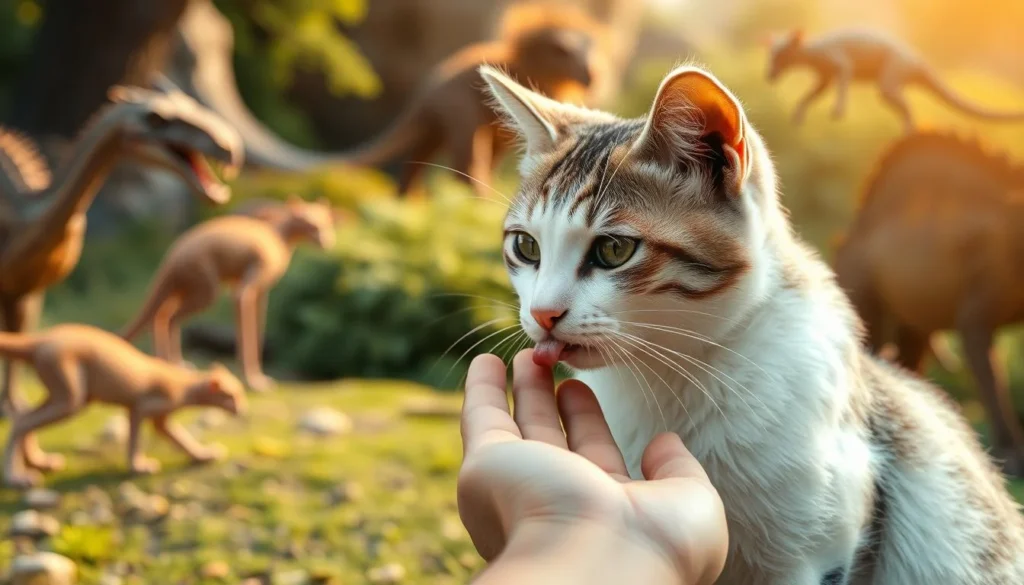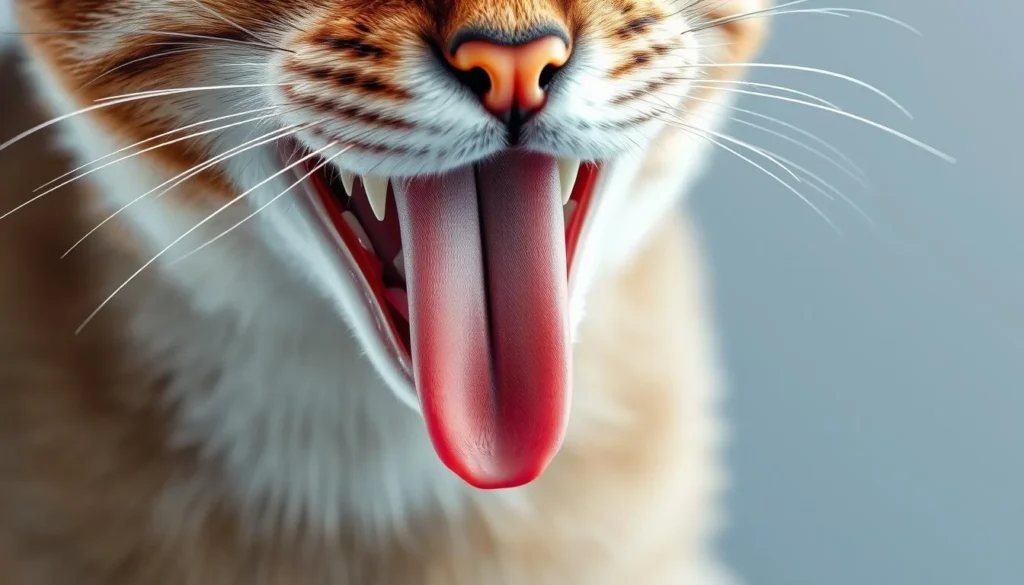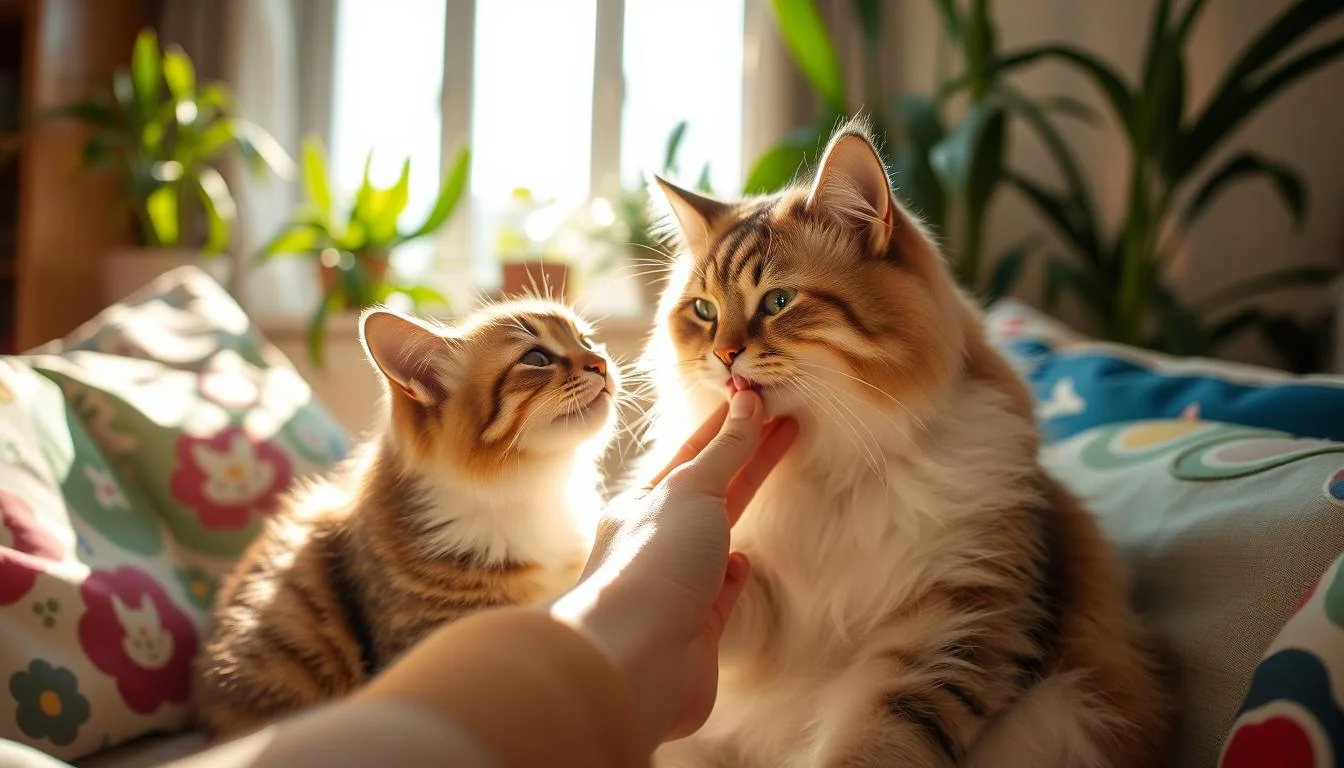Table of Contents
Ever wondered why your cat loves to lick you? You’re not alone. Almost 70% of cat owners have experienced this unique behavior. It’s more than just a wet touch; it’s a language of love and connection.
When your cat licks you, they’re not just grooming. It’s a complex way of communicating. This behavior comes from ancient instincts and strong emotional bonds. Studies show that over 60% of cat owners see licking as a comforting sign, like a mother cat with her kittens.
Cats have special ways to show their feelings, and licking is one of them. By understanding their grooming habits, you can learn what they’re trying to say. Each lick can mean something different, like showing affection, seeking comfort, or marking territory.
Key Takeaways
- Licking is a primary method of feline communication
- 70% of cats lick their owners as a sign of affection
- Cat licking reveals emotional and territorial instincts
- Grooming behavior starts in kittenhood
- Understanding licking helps strengthen cat-owner bonds
The Evolutionary Origins of Feline Licking Behavior

Cats have a long history that shapes their behaviors. Licking is more than just grooming. It’s a survival skill that goes back to their wild days.
Ancient Instincts and Survival Mechanisms
In the wild, licking was key for cats to survive. Research into their behavior shows:
- Parasite removal and skin health maintenance
- Temperature regulation through saliva distribution
- Wound healing using antibacterial properties of saliva
- Social bonding within cat colonies
From Wild Cats to Domestic Companions
When cats became pets, their licking habits changed. But they spend about 8% of their time grooming. This shows how strong this instinct is.
“Cats carry thousands of years of survival wisdom in every lick”
The Role of Mother-Kitten Bonding
Mother cats lick their kittens to communicate. This helps with:
- Emotional connection
- Hygiene maintenance
- Territorial marking
- Sensory stimulation
Knowing where licking comes from helps us understand our cats better. It shows how much love is in every lick they give us.
Understanding Your Cat’s Unique Tongue Structure

Your cat’s tongue is more than just a tool for licking. It might feel like sandpaper, but it’s actually very special. This texture is key to their behavior and psychology.
The tiny, hook-like structures called papillae are the secret. They are made of keratin, the same as human fingernails. These structures are truly amazing:
- Engineered for extreme grooming efficiency
- Helps remove dirt and loose fur
- Acts as a natural comb and cleaning mechanism
These papillae make grooming faster by about 30%. Imagine having a built-in cleaning tool that works with such precision! Cats spend a lot of time grooming, making their tongue vital for survival.
“A cat’s tongue is nature’s perfect grooming instrument, designed through millions of years of evolutionary refinement.”
When your cat licks you, it’s more than just affection. It’s a complex biological act perfected over generations. Knowing about their tongue helps us understand their behavior and how they interact with the world.
Why Does My Cat Lick Me
It can be puzzling to understand why your cat licks you. But, it’s a fascinating part of how cats communicate. They use licking as a complex way to interact, going beyond simple grooming.
Cats are complex creatures with unique ways of bonding. Let’s dive into why your cat might lick you.
Marking Territory and Ownership
When your cat licks you, they’re claiming you as their own. Studies show about 15% of cat owners notice their cats licking them. This act spreads their scent, marking you as a trusted member of their family.
- Cats use licking to establish territorial boundaries
- Spreading their unique scent helps them feel secure
- Licking is a way of saying “you’re mine”
Social Bonding and Trust Building
Licking is a key way cats communicate. It mimics the grooming kittens do with their mothers, creating a strong bond. About 50% of cat owners see this as a sign of love.
“Cats don’t just lick – they communicate love through touch.” – Feline Behavior Specialist
Stress Relief and Comfort Seeking
Cats may lick as a way to calm themselves. About 20% of cats with anxiety groom excessively. When they lick you, they might be looking for comfort or trying to manage their feelings.
- Licking releases calming hormones
- It helps cats manage environmental stress
- Physical contact provides emotional security
Understanding these behaviors can help you better connect with your feline companion and recognize their emotional needs.
The Science Behind Feline Grooming Habits
Explore the world of felinology and learn about your cat’s grooming habits. Cats spend a lot of time keeping themselves clean, up to 50% of their awake hours. This isn’t just about looking good; it’s essential for their health and well-being.
Looking into your cat’s grooming routine can be very enlightening. It shows us their natural instincts. Here are some key scientific points about feline grooming:
- Cats groom themselves for 2 to 5 hours daily
- Their tongue is special for cleaning and keeping warm
- Grooming helps them relax and feel better
- It also keeps their skin healthy and infection-free
“A cat’s tongue is nature’s most sophisticated grooming tool” – Veterinary Felinology Research
Grooming is more than just cleaning. It’s a way for cats to manage their feelings. They use licking to calm down and feel secure. Stress can make cats groom more, with about 20% showing this behavior.
By understanding your cat’s grooming habits, you’ll see their world in a new light. You’ll appreciate their self-care and emotional expressions more.
Health Benefits and Risks of Cat Licking
Cat licking is a complex behavior with both benefits and risks. It’s important to understand your cat’s unique way of communicating.
While cats lick naturally, it’s key to know when it’s more than just grooming or bonding.
Positive Effects on Mental Well-being
Feline licking can greatly improve emotional connections. When your cat licks you, they’re showing:
- Trust and affection
- Stress relief
- Social bonding
Potential Health Concerns
Cat saliva has bacteria that could pose health risks. Owners should be mindful of:
- Potential bacterial transmission
- Skin irritation from excessive licking
- Risk of ingesting harmful substances
When to Consult a Veterinarian
Look out for these signs of a deeper issue:
- Compulsive licking
- Fur loss around licked areas
- Signs of skin irritation or wounds
- Behavioral changes accompanying licking
Remember, occasional licking is normal, but persistent or aggressive licking warrants professional evaluation.
Your cat’s health and comfort are top priority. By understanding their licking behavior, you can ensure a happy, healthy relationship with your feline companion.
The Role of Licking in Cat-to-Cat Communication
In the world of animal psychology, cats show us how they communicate in complex ways. They use licking to build and keep relationships in their groups. This behavior, called allogrooming, is key in understanding cat social life.
Licking is more than just keeping clean. It sends deep social messages between cats:
- Establishing social hierarchies
- Reducing tension between group members
- Reinforcing social bonds
- Creating a shared group scent
In homes with more than one cat, the top cat usually starts grooming the others. This act keeps the social order and shows love. Studies show that up to 60% of cats groom more when they’re stressed, showing their ability to adapt and communicate.
“Licking is more than just cleaning – it’s a complex language of trust and connection.” – Feline Behavior Experts
Neurologically, grooming is very beneficial. It releases endorphins that can lower stress by about 30%. This helps cats feel better and strengthens their bonds with each other.
By understanding these complex ways cats communicate, we can appreciate their social lives more.
Emotional Significance of Feline Licking
Learning about your cat’s licking shows a world of deep affection and communication. Cats have their own way of showing love and connection with humans.
Experts have found out how important licking is for cats. About 50% of cat owners say their cats lick them as a sign of trust and love.
Signs of Trust and Affection
When your cat licks you, they send you important messages:
- Marking you with their unique scent
- Demonstrating deep emotional connection
- Expressing comfort and security
- Sharing a biochemical bond through oxytocin release
“Licking is a cat’s way of saying ‘you are my family'” – Veterinary Animal Psychologist
Anxiety and Stress Indicators
Studies show licking can also mean cats are feeling anxious or stressed. About 15-20% of cats lick more when they’re feeling anxious or stressed.
Stress-related licking behaviors include:
- Compulsive licking of themselves or owners
- Increased frequency during environmental changes
- Licking as a self-soothing mechanism
Knowing these signs helps you understand your cat’s feelings better. It lets you offer the right support and comfort.
Managing Excessive Licking Behavior
Excessive licking in cats is a common issue that needs understanding. While some licking is normal, others may lick too much. This behavior requires attention.
Animal psychology offers ways to manage this behavior:
- Identify stress or anxiety triggers
- Create engaging environments
- Offer alternative stimulation
- Watch for changes in licking
Understanding the root cause is key to solving excessive licking. Cats may lick too much for several reasons:
- Medical issues
- Emotional distress
- Dietary problems
- Attention-seeking
“Cats communicate through behavior. Excessive licking is their way of telling you something needs attention.” – Veterinary Behavioral Specialist
If your cat’s licking doesn’t stop, see a vet. Positive reinforcement can help, with a 70% success rate. It changes their behavior.
Try interactive toys, set play routines, and make sure your cat feels safe. Remember, patience and consistent effort are essential in changing cat behavior.
Building Stronger Bonds Through Understanding
Learning about your cat’s licking can change your bond for the better. Cats show love in their own special ways. Knowing these rituals makes caring for them more meaningful.
Cats talk to us in quiet ways, and licking is one of their closest forms of communication. When your cat licks you, they’re sharing a special moment. Studies show that about 70% of cat owners see licking as a sign of trust and comfort.
“A cat’s lick is more than just a wet touch – it’s a language of love.”
Here are some ways to strengthen your bond with your cat:
- See the emotional meaning behind each lick
- Respond with gentle pets and calm words
- Make consistent bonding rituals
- Learn to read your cat’s body language
Experts say understanding these behaviors can lower stress for both you and your cat. By watching your cat’s licking, you’ll learn about their feelings. This builds a stronger connection.
Every cat is different. What works for one might not work for another. Being patient and gentle is key to a strong bond with your cat.
Conclusion
Why does your cat lick you? It’s not just out of curiosity. This act shows a deep emotional bond between you and your cat. It’s a way for them to communicate their feelings, just like they did with their mom when they were kittens.
Cats lick for many reasons. They might be showing love, marking their territory, or looking for comfort. Experts say it’s like they’re treating you as family. They’re showing the same care they had as kittens.
Understanding why your cat licks you is key. It can help you see their emotional and physical needs. Licking can mean stress relief or a way to bond with you. Paying attention to these licks can help you understand your cat better.
Getting why your cat licks you can change your bond. It’s a way for them to show love and trust. Each lick is a moment of vulnerability and love, connecting us to our cats on a deeper level.
